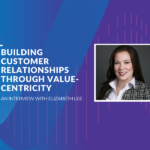The Importance Of A Connected Customer Experience
Improving the customer experience is the most important initiative for revenue leaders to prioritize in 2021. According to a recent Salesforce study, 84% of customers say that the experience a company provides is as important as its products and services (2019). In North America specifically, 62% of consumers now expect to have a connected customer experience from a company.
Creating an outstanding customer experience is a team effort that requires extensive input from one very important stakeholder: the customer. Without this critical source of feedback at every stage of the customer journey, you risk becoming irrelevant to your customers and losing them to competitors that are providing greater value.
By aligning your customer feedback strategy across your customer-facing teams, your organization will be empowered with the insights you need to strengthen your customer success motion and unify the customer experience.
So, how can you launch a strong cross-functional feedback strategy that improves your customer experience? Here are three high-impact, easy to implement actions you can take:
1. Build your feedback strategy in collaboration with your customer-facing teams
Creating a stellar customer feedback strategy requires alignment on two important fronts: your company and the customer. When it comes to the customer, your customer-facing teams need to clearly understand who they’re targeting. As a cross-functional exercise, we recommend developing two distinct customer profiles for your organization: an ideal customer profile (i.e. the customers you’d like to acquire, retain and expand), and a current customer profile (i.e. the customers you have now). Developing these profiles in collaboration with your customer-facing teams will allow you to clearly identify the most important customer feedback to collect and analyze, based on your customers and their needs.
In addition to identifying your customers, it’s critical that your customer-facing teams also understand the organizational goals that will drive your feedback strategy. By having an open discussion on this topic, your teams should be able to confidently answer the following:
- Why will collecting feedback help us achieve our organizational goals?
- Who specifically are we collecting feedback from?
- What types of feedback do we need to collect, analyze, and prioritize?
- Where are we collecting feedback, and where will we store and share this data internally?
- When are we requesting feedback from the customer, and when will we share this data internally?
2. Organize daily, bi-weekly, and monthly meetings to share customer feedback across your organization
With an endless stream of customer feedback coming in, you need to ensure that your teams are regularly sharing these insights cross-functionally. Organize a monthly all-hands with your sales and post-sales teams to discuss the feedback gathered throughout the entire customer journey. These meetings will highlight the key achievements and challenges your customers are facing, which will help surface what’s working well and where there are areas for improvement in your overarching customer experience.
In order to get the most value out of the customer feedback you’re collecting, consider setting up bi-weekly meetings with your customer-facing teams. We recommend that you use this time to analyze this data on a deeper level and get input from the leaders of each customer-facing team. Additionally, arranging a daily standup between your customer success, product, and customer support teams to ensure each team is aligned on the key priorities and tasks that need to be completed to support your customers each day.
3. Leverage data and technology in your customer feedback strategy
Once you’ve strengthened the alliance between your customer-facing teams, it’s time to operationalize your strategy. Consider investing in software that allows your organization to collect, centralize, analyze and take action on customer feedback. Selecting the right technology investment for your company will be based on your organization’s unique goals, team structure, and customer needs. Gainsight CX is a great example of a platform to consider, depending on the depth and breadth of your customer feedback model. With the right technology in place, your team will be empowered with centralized and accessible customer feedback that will help them accelerate your customer experience.
Connecting Your Company And Your Customers
As you can see, there are several opportunities you can seize to improve the customer experience in your organization. We understand that this can be a challenging initiative to put in motion, but we’re confident that these actionable steps will point you in the right direction.
By aligning your customer-facing teams to improve your feedback loop, your customers will feel valued and your organization will be empowered to tackle difficult product decisions, identify new opportunities, and address potential gaps in the customer experience.
The choice is yours, but it’s one you must make in order to continue improving your customer experience.
Looking for more insights on how to create an exceptional customer experience? Read our latest article on how to build a best-in-class customer success strategy.





